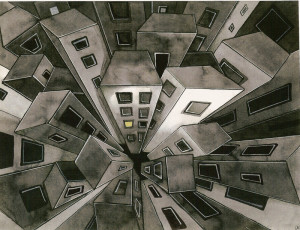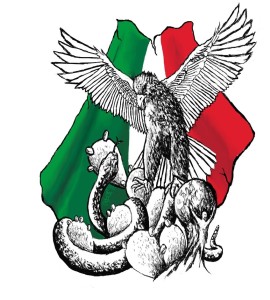Dearest Nerds!
We’re pleased as a gaggle of mad scientists with a new time-travel scheme!
Pleased-er, in fact, because we have a impressive line-up of themed “lightning talks” for you this month!
Please welcome a cadre of Urban Studies fellows from U Chicago to talk (quickly!) on a fantastically diverse set of topics about the world we live in.
This different format consists of two sessions of 3 or 4 ultra-dense, 5- to 8-minute presentations back-to-back. (Don’t worry, you can still ask questions at the end of each session and there will be a break for more beer. )
Though the format has changed, the rest stays the same:
You know the moves, NerdNiters!
Thursday, May 26th at the Bottom Lounge
Doors open at 7pm
First speaker at 8pm
Done and drunk by 11pm.
Sticky Schools for a Sticky Situation
Civil Rights and Chicago’s Hidden History of School Choice
Ever wonder where magnet schools came from? Part of the answer is buried right here in Chicago, where fifty years ago, a collision of civil rights activists, urban planners, and educational theorists launched a cautious experiment with integrated education in a segregated city.
My talk sketches an origin story for Chicago’s magnet schools, one of the nation’s first experiments in choice-based school desegregation.
Nick Kryczka is a lifelong Chicagoan and currently a PhD candidate in history at the University of Chicago. He used to have a real job as a history teacher in the Chicago Public Schools. His time away from gargoyles and quadrangles is spent on the Northwest Side where he raises a family and bugs his neighbors and his alderman with fancy talk about community and democracy.
Not Your Typical Thanksgiving Feast Play
Little Indians Growing Up in the Big City
After two years of “deep hanging out” in a city in middle-of-nowhere Michigan with lots of cool American Indian folks, I learned about education and urban issues from an oft-forgotten angle. By the power of anthropology, this, of course, qualifies me to speak – as an expert – on anything even vaguely Indigenous, educational, or related to cities.
Consequently, I’ll begin this talk with “Things That Smell Strange for 200, Alex!” Yes, Chicago, I mean you. As for the rest? Blah blah identity blah blah cooking blah blah success. Want to learn more? Come and see!
Andrea “Dréa” Jenkins, almost-PhD, is a rising nerd from the planet Anthropology who regularly visits the realms of Education, Public Policy, and Race & Ethnic Studies. In addition to her fine UChicago education, she draws her nerd heritage from hours spent escaping banal reality with the likes of Arthur Conan Doyle, Gene Roddenberry, Anne Bishop, Joss Whedon, and Octavia Butler, boldly geeking out across the universe in a transnational, multicultural theory-mobile of her own making.
What About Sex Worker as Worker?
Sex Worker as Gentrifier/Sex Worker as Nuisance
Remember when New York’s Times Square and Chicago’s Rush Street were all dirty and seedy and there were grungy adult stores everywhere? Well, I was born in the 80s, so I don’t either. What I do know is that there is this constant debate about whether adult establishments like these are “good” or “bad” and I think that’s the wrong debate we should be having. I talked to a bunch of people, and read a lot of news articles, and looked at a lot of boring (to you) zoning laws to check to see what some of the issues around adult businesses are. Anyway, some people that think burlesque clubs are awesome and cool (i.e., are popular among hipsters and might lead to gentrification) consider strip clubs to be bad and gross, which I think is weird, and maybe a little hypocritical and classist.
Come and find out more and ask me a bunch of questions I probably don’t have the answer to!
Theresa Anasti is a PhD Candidate in the field of professional do-gooding (social work), where she is interested broadly in the realm of community organizing and political activism on behalf of marginalized populations. She likes running throughout the city and sometimes has tried to run away from her dissertation but it always manages to catch up with her.
Making Lemonade
The National Council of Negro Women and Black Women’s Activism
As recorded so memorably on Beyonce’s lastest work, Black women have taken life’s lemons of sexism, racism and classim and turned it into a delicious intersectional feminism. My work builds on this theme of Black social activism by focusing on the history of the National Council of Negro Women. This Black women’s club was founded in 1935 by famed activist Mary McLeod Bethune as an outcropping of the social and civic groups of the late nineteenth century. The NCNW was founded to harness the organizing power of Black women to gain access to better jobs and to seek social and political equity for African Americans.
My project will allow you to make historical connections to some of the themes Bey sang about in her album Lemonade, and learn a bit about the joy of Black women’s organizing power across the diaspora.
Ashley J. Finigan is a Brooklyn expat currently pursuing her PhD in American History at the University of Chicago, with a focus on African America and women’s history. Along with her scholarly pursuits she is a self-styled TV critic, watching copious hours of TV across all platforms. She also enjoys letter writing and listening to comedy podcasts. Be in touch with new pod cast recommendations!
How to Build a Megalopolis
Mexico City in the Twentieth Cent ury
ury
A quiet, parochial town at the beginning of the twentieth-century, by the 1980s Mexico City had become the largest city in the world. Mexico City was not developed by urban planners but by migrants, squatters, and corrupt politicians. It became the epitome of urban dynamics gone wrong: poverty, inequality, pollution, crime, and overpopulation.
In this talk I will evaluate Mexico City’s demographic explosion, asking who built the city, who benefitted from its growth, and what does all this tell us about how cities work? Perhaps Mexico City was not a planning disaster but a place that developed in its own way, and, in some crazy way, it worked.
Emilio de Antunano Villarreal’s love affair with cities and architecture began as a child, building Lego houses while living in what was considered at the time—the 1980s—the world’s largest urban disaster: Mexico City. He is now a historian, living in Chicago and trying to make sense of another disaster: his dissertation! He enjoys running along the lake, riding the L-train, and grabbing a beer in one of Chicago’s many fine establishments—even if that requires talking about this dissertation.
The Government Just Wants Our District to Go Crazy!
Numbers and the Development of Community Mental Health in China
In recent years, community health workers across China have received a curious task: to find a certain percent of persons with serious mental illnesses at a given community and to manage them. As part of a new state-run community mental health program, this use of numbers has aroused a lot of controversies, s uch as the critique that it is not scientific and the concern that it may force health workers to fabricate data.
uch as the critique that it is not scientific and the concern that it may force health workers to fabricate data.
In this talk, I draw on my ongoing fieldwork with program workers and interviews with policymakers, in order to understand why the construction of a community mental health infrastructure hinges upon the assignment, collection, and monitoring of numbers. I argue that the seemingly objective and simple numbers contain within them multiple historically situated values, such as the old idea of socialist central planning and the new aspiration for global science. I also track the numbers’ traveling across urban space, in order to show how these values might unravel in practice. In general, I hope to discuss with you the promises and perils of relying on numbers in social service administration, a phenomenon that we encounter almost everywhere in the world.
Zhiying Ma is a Ph.D. candidate at the University of Chicago. So far her life has constantly been in between places: raised in a small town (by the Chinese standard) and then went to big cities; traveling between China and the United States; always studying multiple disciplines (hence perhaps not quite a nerd in any) at school… It’s probably this in-betweenness and out-of-placeness that makes her interested in when and how one counts for something.
